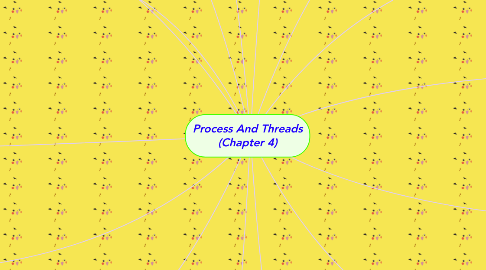
1. Process Elements
1.1. Program code.
1.2. A set of data associated with that code.
2. Process Elements
2.1. Identifier
2.2. State
2.3. Priority
2.4. Program Counter
2.5. Memory Pointers
2.6. Context data
2.7. I/O status Information
2.8. Accounting Information
3. Process Creation
3.1. When a new process is to be added to those currently being managed processes.
3.2. Operating system builds the data structures.
3.3. Process Spawning
3.3.1. The OS creates a process at the explicit request of another process .
4. Process Termination
4.1. Means that a process to indicate its completion
4.2. Reasons for Process Termination
4.2.1. Normal copletion
4.2.2. Time limit exceeded
4.2.3. Memory unavailable
4.2.4. Time overrun
4.2.5. I/O failure
4.2.6. Invalid instruction
5. Five-State Process Model
5.1. New
5.1.1. A rpocess is being created
5.2. Ready
5.2.1. A process that is prepared to be executed when given chance
5.3. Running
5.3.1. A process that is currently being execuited
5.4. Blocked
5.4.1. A process that cannot execute until some events occur, such as I/O completion.
5.5. Exit
5.5.1. A process that has finished its execution.
6. Processes And Threads
6.1. Resource Ownership
6.2. Scheduling/Execution
6.3. Unit of dispatching is referred to as a thread or lightweight process
6.3.1. Thread is a basic unit of CPU utilization.
6.4. Multithreading
6.4.1. The ability of an OS to support multiple, concurrent paths of execution within a single process.
7. Single Threaded Approaches
7.1. concept of a thread is not recognized
8. Multithreaded Approaches
8.1. Java run-time.
9. OS Management Of Application Execution
9.1. Resources are made available to multiple applications.
9.2. The processor and I/O devices can be used efficiently.
10. OS Process
10.1. Program
10.1.1. Passive entity such as contents of a file stored on disk.
10.2. Process
10.2.1. Active entity with a program counter specifying the next instruction to be executed.
11. Process Control Block
11.1. Contains the process elements.
11.2. Created and managed by the operating system.
12. Process States
12.1. Trace
12.1.1. sequence of instructions that execute for that process
12.2. Dispatcher
12.2.1. small program that switches the processor from one process to another
13. Two-State Process Model
13.1. A process may be in one of two states
13.1.1. Running
13.1.1.1. The process is currently being executed.
13.1.2. Not-running
14. Benefits Of Threads
14.1. Takes less time to create a new thread than a process
14.2. Less time to terminate a thread than a process
14.3. Switching between two threads takes less time than switching between processes
14.4. Threads enhance efficiency in communication between programs.
15. OS Control Structures
15.1. Four different types of tables maintained by the OS
15.1.1. Memory tables
15.1.2. IO tables
15.1.3. File tables
15.1.4. Process tables

